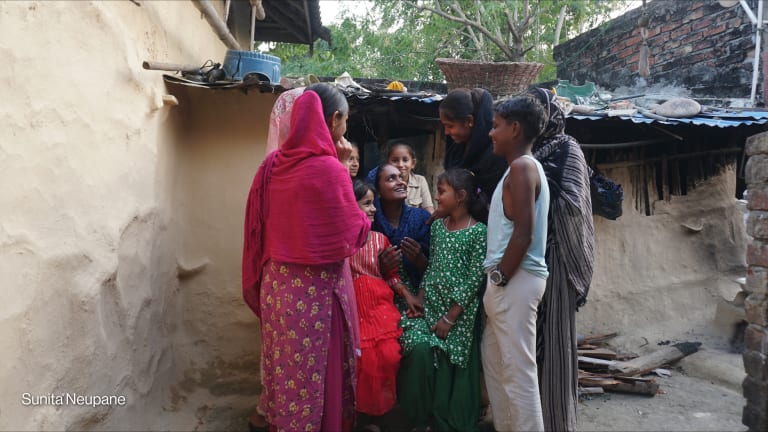
Sara Fajardo and her husband met in Baltimore, planned their wedding from a tent in earthquake-struck Haiti, welcomed their son in Nairobi and are expecting their second child in their new home in Peru — all while balancing two travel-heavy jobs.
Follow the rest of the series and share your own advice using the hashtag #DevCouples.
Many people would file this series of events under hectic, dangerous and exhausting. To other dual-career couples working on international development or humanitarian causes, it sounds downright normal.
Fajardo first met her husband when she interviewed for a job as a communications officer; he was the recruiter tasked with sourcing candidates for the position.
“He said later that if I got the job, he knew he’d pursue me,” Fajardo said with a laugh. “I got the job … but it took us nine months to start dating.”
After nearly five years of regional work in Africa, Fajardo and her husband made the decision that something had to give; her extensive travel — which she was able to do with their young son — combined with his 75 percent time commitment in the field often meant they had just two or three days a month together.
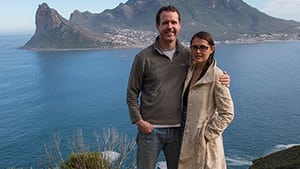
Recently relocated to Peru, Fajardo will finish work with her current employer in March and focus on consulting thereafter to spend less time on the road, in the air or on Skype — and more time with her growing family.
This decision, too, will sound familiar to many development couples.
Global development attracts ambitious, passionate, goal-driven people who have a hard time stepping away from pressing matters to prioritize themselves and their relationships. Juggling frequent travel schedules, aligning overseas assignments and weathering separation in non-family friendly duty stations, every dual-career couple will face tough decisions as they navigate their own work-life balance. And every country harbors stories of infidelity, of the couple who met in a hardship post only to split when the project ended, or the two who took separate posts and grew distant.
But it is, of course, possible to stay together — though it often means mastering long distance. Not surprisingly, clear relationship expectations, communication and shared understanding of the work are just a few of the things that can set a couple up for success, according to those who have been there.
Partnership first
For Stephen and Dana Ladek, the first question was always: How can we choose our partnership over our careers?
The two met in graduate school, were engaged within seven months and always knew they wanted to take their careers overseas. It was during their conversation after their engagement, Stephen Ladek explained, when they decided they’d never live in separate locations, which includes never taking a job with more than 50 percent travel time.
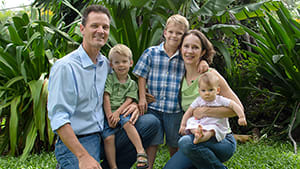
“We had a friendly competition to see who could get the first job,” he said. “She got three offers and I got zero, so we followed her career … and still do to this day.”
Ladek quit his job and called on his entrepreneurial spirit to found a consulting firm, which has allowed him to work from anywhere in the world. His wife, in the meantime, rotates every five years with the International Organization for Migration. They’ve enjoyed posts in Jordan, Hungary and Costa Rica and have three children, one born in each country.
“I'm sure we've ‘missed’ opportunities along the way, and I know we've actively said no to others because of these criteria,” Ladek said. “Neither of us has noticed.”
“Free yourself from your expectations so that what you do end up building — that’s OK.”
— Stephen LadekIt works for them, explained Ladek, because his wife appreciates the structure of a large organization while he is able to flex his creative side. No matter what, Ladek said, your definition of normal probably isn't going to apply anymore, especially if that normal is a white picket fence on the corner of Main Street.
“Free yourself from your expectations so that what you do end up building — that’s OK,” Ladek suggested.
Staying together in such a field does require a certain degree of flexibility from both partners, said Dale Rachmeler, who, together with his wife, has spent 41 years working overseas.
“Neither of us are so headstrong to rule out the needs and desires of the other person,” he said. “It is a great life and is certainly feasible to do if you are flexible … combined with a bit of luck.”
Communicate — when apart
What worked for the Ladeks might not work for everyone, especially if neither partner has the work flexibility. In these cases, ask: How long are you willing to be apart? It’s a question every development couple will face. Maybe it’s a week, maybe it’s five months, but communicating these boundaries early will make future career decisions easier.
“You do get so committed to what you’re doing,” Fajardo explained. “You feel this calling to continue to respond, but sometimes you need your partner to say ‘you need to come home and regroup.’”
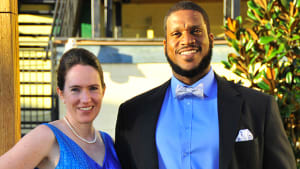
For some couples, separation is inevitable if a great opportunity presents itself. This is when communication becomes paramount.
Shannon Oliver and Torrey Peace are currently together in Timor-Leste — but only for a few more days. Oliver will return to his work in Afghanistan after visiting Peace at her post during his two-week break.
The two met while working in South Sudan and married in Thailand in April 2013. Shortly afterward, they found out Oliver’s position would be cut. By August, Oliver, who is no stranger to hardship posts, was headed to Afghanistan for the best opportunity of his career.
“I’m not sure how many wives would have been supportive,” he said.
“I didn't want to be the person to shut Shannon down when he had a great opportunity,” added Peace, allowing that she was upset at first about him heading to an insecure environment.
Growing up in a family where seeing and being with the person you love is really important, “it was a paradigm shift for me, when I found out that the first two or three years of my marriage, I wouldn’t be living with my husband,” Peace said.
“It was a paradigm shift for me when I found out that the first two or three years of my marriage, I wouldn’t be living with my husband.”
— Torrey PeaceBefore the newly married couple parted, they made a list of expectations to clearly define what their long distance relationship would look like: How often would they talk? How would they use their rest and relaxation breaks? How long would they live apart?
Infidelity is common in the development industry, Oliver noted, and some people have polyamorous relationships — known more casually as an MBA, or “married but available ” — but the two agreed that this wasn’t something they were interested in. They’re able to see each other every two to three months, and have realized that four months — the longest they’ve spent apart — is too long.
“You might think you are aligned, but it’s better to communicate and be sure,” Peace said, adding that they’ve revisited the document when necessary over the past year and a half apart.
Right now, the couple Skypes every day. And once a week, they block out three hours for joint Skype calls with their parents and extended family. Their time frame keeps shifting — initially it would be two years apart and now it might become another year and a half — but their own confidence in their relationship is what makes it possible.
“Don’t let other people define your relationship or decide what’s good and bad for you as a couple,” Peace said.
In the meantime, the two have launched a podcast to share their long-distance relationship experience with others. They’re calling it “Two Mules in a Field,” so named after a family member told them their relationship “is like two mules in a field — as long you're moving in the same direction, everything will be OK.”
Communicate — when together
If you’re allergic to a lot of talking, sharing and planning, managing the stress of a dual-career development relationship may prove too much.
“I don’t think I've ever discussed a relationship so much in the beginning as I did with him,” said Yassica Ferrer of now-husband Keith.
Their situation called for even more communication — between each other and with their employer — since they met when Ferrer was operations officer and Keith was a chief of party for the same project in Pakistan.
After working things out in terms of reporting and reviews, the two spent one-and-a-half years as a couple in Pakistan. And despite the stigma of couples getting together in hardship posts, then going separate ways, “sometimes things work out beyond that,” Ferrer said.
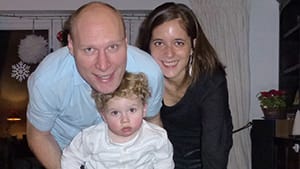
Ferrer visited Keith in his native England, then took a position based in Washington; the two ended up with overlapping work in Sierra Leone. Six months later, Keith flew to the U.S. capital and proposed. In February, the two married in Las Vegas. And in June, Ferrer moved to England.
The decision of where to live was an easy one, said Ferrer, who was 35 and wanted to start a family, while Keith wanted to spend time in the United Kingdom, where Ferrer was able to tap into his contacts for short-term work.
“We like development work, but we’re enjoying our time in England now,” Ferrer said. “I think if Keith was that person who fed off of constant extreme situations, it wouldn't have worked … We like a balance, that works for us.”
Reconnect — but set boundaries
Travel is inevitable for most development professionals, which means time together is even more precious.
“You can get disconnected when you're seeing something that the other person is not seeing,” Fajardo said. “What are we going to do to make sure when you come home, or I come home, we can become a family again?”
Maybe that’s going for walks, making dinner together or taking a weekend trip, something Fajardo plans when her husband has been gone.
Working in the same industry also allows the two to identify with the stress the other might be facing. After working long hours in Haiti or South Sudan, her husband would be in tune with her mental state, Fajardo suggested.
But at other times, especially if two people work for the same organization, it can become too easy for work life and home life to mesh. Sometimes listening to your partner after they've had a long or difficult day — and refraining from trying to help them address the situation — is what’s needed more than suggestions, Yassica Ferrer shared.
The amount of negotiation, timing issues and sacrifice couples who work internationally face is striking. And one thing is for sure: It will look different for every couple.
While the Ladeks will prepare for their next international move in less than two years, Shannon Oliver and Torrey Peace plan to head back to the United States in three to four years — they’re already making plans to hike the Appalachian Trail.
“We all by necessity have to be spin doctors,” Stephen Ladek suggested. “You have to ask: ‘Is there a way that I can commit to this relationship and continue to satisfy my passion?’”
If your passion is gender-based violence, for example, maybe you can find a way to move the needle that also allows you to invest in a relationship, or to have children, he said. Maybe it isn’t field work, and maybe that’s OK, too.
What’s your advice for dual-career couples working in international development? Leave a comment below or tweet using the hashtag #DevCouples.
Whether you’re a seasoned expert or budding development professional — check out more news, analysis and advice online to guide your career and professional development, and subscribe to Doing Good to receive top international development career and recruitment news every week.




